|
Return to Hiker's Notebook Home PageCommon Name: Club Moss, Running pine, Staghorn club moss, Wolf claw club moss, Ground pine, Running moss, Princess pine - The common name describes the club-like appendages at the end of a long stalk that extends upward from the moss-like basal plant, the overall effect is a moss with clubs.
Scientific Name: Lycopodium clavatum - The generic name is from the Greek words lukos meaning wolf and podos meaning foot; the tips of the branches are reminiscent of a wolf paw. The specific name is from the Latin clava meaning club which accentuates the club-like extensions.
Club mosses are the vestigial relict of the earliest land plants which evolved in the Devonian Period about 395 million years ago. Members of this group of plants included tree lycopods of the extinct genus Lepidodendron that were up to 100 feet in height whose deposition and decay during the Carboniferous Period engendered the world's major coal fields. The club moss is not a moss since it is vascular; mosses are non-vascular bryophytes. Botanically, vascular refers to the evolution of specialized xylem and phloem cells that provide for the fluid transfer necessary for nutrient provisioning and sufficient for complex structure. Club mosses are often referred to in the vernacular literature as lycophytes or lycopsids in reference to earlier taxonomies that placed them in the divisions Lycophyta and Lycopsida, now in desuetude due to the revelations of DNA associations. Club mosses are now generally grouped in a separate class, Lycopodiopsida. The life cycle of the club mosses, like that of the ferns, is a combination of a spore producing phase (sporophyte) and a sexual phase (gametophyte), an arrangement that appears to mark a transitional phase in the evolution of plants. The cycle nominally starts when a single spore among the billions produced successfully germinates and forms one of two different pre-sexual bodies called prothalli. While some prothalli are photosynthetic and epigeal, growing on top of the soil, most are hypogeal, buried by accumulated debris or faunal motive activity to depths of up to 4 inches.
The growth and the development of the underground club moss prothallus is unique in that it not only lies dormant for up to 7 years after subterranean deposition but takes up to 15 years to reach sexual maturity. As the hypogeal prothalli do not receive solar radiation, they have no chlorophyll and are accordingly not photosynthetic and cannot produce their own food. They necessarily rely on fungal hyphae to provide nutrition during their protracted growth phase of the club moss life cycle, a relationship that is known as mycorrhizal, meaning "fungus root" in Latin. While 90 percent of all plants have mutualistic, mycorrhizal relationships with fungi, the mutualistic plants provide a quid pro quo in supplying carbohydrates to the fungus in exchange for improved root performance and mineral uptake. The club moss prothalli, so far as is known, provide nothing in return. The antiquity of the club moss and its concomitant dependence on mycorrhizas lends credence to the hypothesis that fungi and plants coevolved on land from aquatic provenance some 400 million years ago.
The purpose of the prothallus is to produce the sexual gametes; it is the gametophyte of the club moss life cycle. The male gamete is called an antheridium and the female gamete is called an archegonium. After the 15 or so years that it takes to reach sexual maturity, the motile antheridia swim away from one area of the prothallus and seek out the mature archegonia in a different area of the prothallus. The sperm-like antheridia have flagella as a means of propulsion and therefore require water in order to consummate the sexual act. The boggy habitat of club mosses is thus a prerequisite to procreation. If all goes well, a fertilized zygote is formed and the familiar moss-like sporophyte phase of the life cycle eventually emerges from this stochastically improbable union. Given the circuitous and protracted growth process, it is not surprising that replication of club mosses is predominantly by vegetative growth, and not by sexual reproduction.
Club mosses are perennial, evergreen plants with small, narrow and crowded
leaves that circumscribe the upright stems in uniform ranks that range from 4
to 16 depending on the species. This means that if you look down the stem from
one end, the leaves will appear in a line going along the stem, like soldiers
in formation. The miniscule leaves in regular ranks are very similar in
appearance to small evergreen needles so that the overall effect is one of a
small pine tree growing on the ground. The common name ground pine provides a
descriptive mnemonic that ensures its perpetuation. Some species of club moss
have a more flattened leave structure like that of a cedar and are called
ground cedar, though the terms ground pine and ground cedar are frequently
used interchangeably for the same plant. The club moss Diphasiastrum
digitatum, the branches extending like fingers of digits, is an example
(above
The reproductive spores of the pine-like club moss sporophytes are in clusters called sporangia that are borne on cone-like structures called strobili at the top the plant, sometimes on the end of a long stalk (as is the case with L. clavatum pictured at the top). The name strobili is from the Latin word for pine cone, which is consistent with the general appearance and reproductive function of the appendage. The elevation of the strobili accentuates wind dispersion of the spores to increase the possibility of successful germination. Club moss spores have a surprisingly broad cultural relevance due to an interesting confluence of properties: they are remarkably uniform in size, they have a high oil content, they are water-repellent, and they are miniscule.
The uniformity of club moss spores makes them ideal for the calibration of microscopic observations; specifically, they are sold as spore marker-grain tablets for spiking pollen samples. A single tablet containing a statistically consistent number of spores is dissolved in water with a pollen sample that has been hydrolyzed and decanted.. Since the size of the spores is essentially constant and since they are so small, complete and uniform dispersion is achieved to yield a constant spore concentration (Cs). When a microscopic slide is prepared from the pollen and spores solution, the observer can count the pollen particles (Np) and spores (Ns) that are visible in the field of view. The pollen concentration can then be computed by multiplying the ratio of the pollen particles to spore particles by the concentration of spores.
C pollen = (Np) / (Ns) X (Cs)
The advantage of this method is that you do not need to determine the amount of liquid in the field of view, which would be difficult at best and would likely result in an unacceptable margin of error.
All small particles have the propensity to ignite in a cascade when subject to an otherwise insignificant heat source when sufficient numbers are available to sustain the chain reaction. Periodic grain elevator explosions are the most infamous manifestation of this effect. The spores of the club moss are exceptionally volatile due to their small size and their oil content. They were accordingly once used as a means of achieving a flash illumination for early photographic compositions. The effect was so prominent that the spores were referred to as "vegetable sulfur" to establish their similarity to the element responsible for the rapid ignition of matches and a key ingredient in gunpowder. The incendiary nature of the spores has been exploited for special effects since the late 19th Century, when "witch meal" was used in theatrical productions where scintillating light accentuated a mysterious occurrence or accompanied a feat of thaumaturgy.
Lubricity is imparted between two surfaces in contact when a substance is placed between them that minimizes the attendant coefficient of friction. Club moss spores are ideally suited for this application as they are in essence small, oily spheroids that act like ball bearings. They were once used by the pharmaceutical industry as a coating for pills and suppositories to prevent them from sticking to each other. The "dusting powder" effect of the spores is still exploited in body powders for bed-ridden babies and adults and as a means of lubricating rubber products. There have been some cases of allergic reactions that range from a mild skin rash to acute asthma that have been attributed to the use of club moss spores as a dusting agent on latex rubber condoms. The application of powder for the amelioration of chafing extended to the use of the spores for medicinal purposes, notably in the treatment of skin irritations such as eczema, boils, dermatitis and herpes.
Native American use of the club moss was extensive and widely variable according to the customs of the individual tribe. The Carrier or Takulli Indians inserted spores into the nasal cavity to promote bleeding to relieve headache pain; the Potawatomi Indians used the spores as a styptic and coagulant in vulnerary treatments. A tea made from boiling the branches was used by the Iroquois to induce pregnancy and by the Aleut Indians to treat postpartum pain. The medicinal uses of club moss extended to European and colonial folk medicine, treating a wide range of ailments that ranged from diarrhea to general fever and weakness; it was even promoted as an aphrodisiac. Although some of these treatments demonstrated the placebo effect, there is some credence to the efficacy of others, as over 100 alkaloids have been isolated from the various club moss species.
The club mosses of North America were until relatively recently all
taxonomically assigned to the genus Lycopodeum; they are now split
among 16 genera globally of which 7 are found in the mid-Atlantic
|
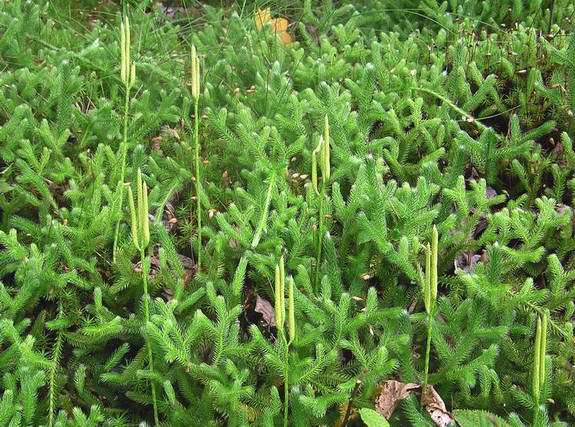
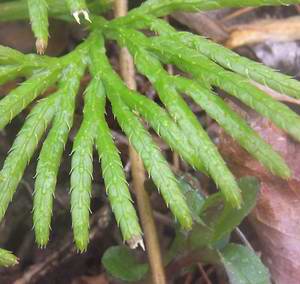
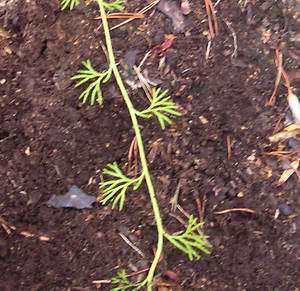 right).
Closer observation reveals that the individual plants are not solitary, but
rather are connected to each other by a stem called a rhizome that travels
along the ground. It is the rhizome that is responsible for the expansion of
the plant from the original incipient zygote, as it vegetatively grows each
year with new vertical stems ascending at periodic intervals. Over time, an
anastomosis of what appear to be individual plants can cover large areas of
the forest in an expansive colony; the alternative common name running pine is
a reflective of this more subtle nature of the club moss. As the cedar-like
club mosses also grow vegetatively, they are also frequently called running
cedar.
right).
Closer observation reveals that the individual plants are not solitary, but
rather are connected to each other by a stem called a rhizome that travels
along the ground. It is the rhizome that is responsible for the expansion of
the plant from the original incipient zygote, as it vegetatively grows each
year with new vertical stems ascending at periodic intervals. Over time, an
anastomosis of what appear to be individual plants can cover large areas of
the forest in an expansive colony; the alternative common name running pine is
a reflective of this more subtle nature of the club moss. As the cedar-like
club mosses also grow vegetatively, they are also frequently called running
cedar.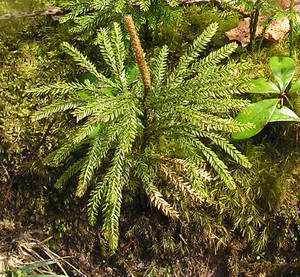
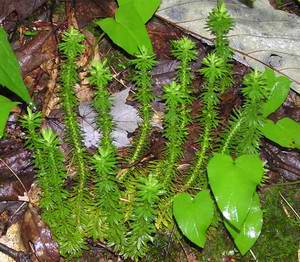 region.
In addition to Diphasiastrum (D. digitatum or ground cedar is
pictured above), the other most common genera are Dendrolycopodium (Dendre
is the Greek word for tree) and Huperzia (named for Johann Huperz, a
noted German pteridologist). The former is exemplified by D. Obscurum,
the flat-branched tree club moss (right) and the latter is exemplified by
H. lucidum, the shining fir moss (left).
region.
In addition to Diphasiastrum (D. digitatum or ground cedar is
pictured above), the other most common genera are Dendrolycopodium (Dendre
is the Greek word for tree) and Huperzia (named for Johann Huperz, a
noted German pteridologist). The former is exemplified by D. Obscurum,
the flat-branched tree club moss (right) and the latter is exemplified by
H. lucidum, the shining fir moss (left).